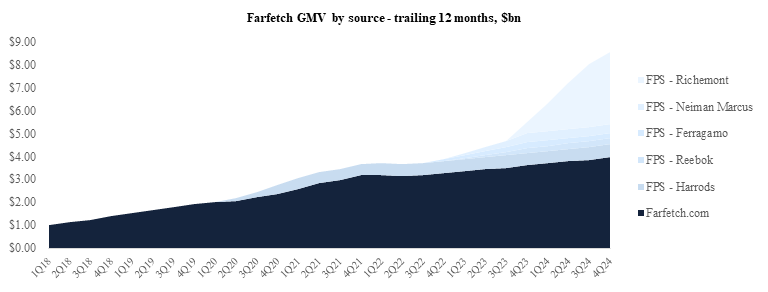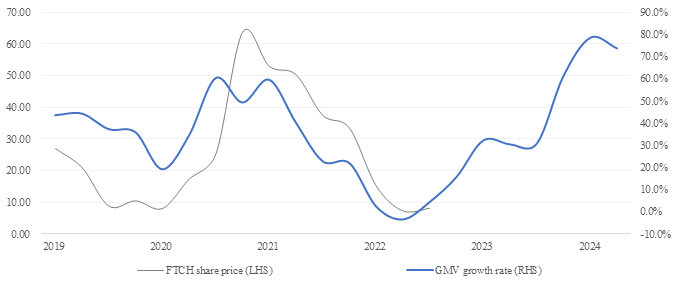Farfetch (NASDAQ: FTCH): the two-stage rocket
Farfetch (NASDAQ: FTCH) is the world’s foremost luxury retail e-commerce platform.
The company was founded to act as an online marketplace (Farfetch.com) by aggregating the inventory of hundreds of luxury apparel brands and independent boutique stores, for purchase by millions of customers, all around the world.
Farfetch.com developed the world’s best back-end infrastructure, front-end user experience, and transport/logistics network to efficiently process the millions of cross-border luxury apparel purchases made through its site each year. It’s enjoyed the fruits of its labor: Farfetch.com process 4x the transaction volume, carries 8x the SKUs, and has 10x the brands featured nearest to its largest competitor. The website is ubiquitous in the luxury industry.
However, FTCH the company is a two-stage rocket: Farfetch.com igniting the first, blasting through the worst gravity and grittiest friction inherent with building a world-class e-commerce tech stack, logistics, and brand relationships with notoriously intractable fashion Maisons. The second rocket is Farfetch Platform Solutions (FPS).
FPS white labels the expertise developed at Farfetch.com and licenses it directly to luxury fashion brands, and department stores to power their own websites and e-commerce. It is solving numerous, near-identical problems faced by hundreds of brands and retailers seeking an e-commerce revenue stream. FPS earns income by receiving a % of all sales generated through the sites it is powering - its ‘take-rate’.
More than 20 luxury websites are currently operated by FPS. Visit Ami Paris. You won’t see it displayed, but you’re scrolling a site built and maintained by FPS. Purchase an Ami product through its web store and FTCH takes a cut.
FPS is an excellent business because it is so value-additive to clients and so profitable to FTCH. Revenue received by FPS is devoid of variable costs because these are borne by the client: the physical goods, transaction processing, transportation, and advertising – all are costs paid by the client.
Instead, FPS experiences a period of cost investment without revenue while its engineering team builds the new client site and capabilities before going live. Then, one day in the middle of the night, a switch is flicked, and the FPS site replaces the outdated version. From that day forwards, FPS enjoys a cut of the site’s transactions with its expenses being the fixed wages of the FTCH tech team operating the site. It is one of the highest flow-through business models we have discovered.
Our enthusiasm for FTCH as an investment has increased because FPS has been announcing new, large client mandates with brio. Prior to 2022, only Harrods among FPS’ existing 20+ brand clients was considered a very large player. This year, FPS has announced four game-changing client wins. Richemont, announced in August, is likely to generate more revenue than all other FPS accounts combined.
|
FPS major client wins |
Announcement of engagement |
Anticipated start date |
GORA est. of GMV $mn |
|
February 2019 |
February 2021 |
$475 |
|
|
August 2022 |
December 2022 |
$225 |
|
|
April 2022 |
January 2023 |
$250 |
|
|
April 2022 |
March 2023 |
$385 |
|
|
August 2022 |
January 2024 |
$3,000 |
The 2022 mandate wins for FPS will transform FTCH. Salvatore Ferragamo, Reebok and Nieman Marcus all go live over the next 12 months. That will bring almost $1 billion of annual Gross Merchandise Volume (GMV) flowing through the FPS tech stack – netting FTCH north of $100 million annually for its efforts.
None of this revenue is being earned today, only the costs of the engineers re-platforming these websites are presently visible in FTCH financials. However, the inflection is coming.
The big one here though is Richemont. Richemont is a luxury empire spanning 26 well-known brands generating combined sales second-only to the LVMH empire. FPS will soon be driving the e-commerce arm of all Richemont brands following the announcement of a multi-faceted agreement that sees equity exchanges between the two companies as well as Richemont’s brands being added to the Farfetch.com marketplace. Richemont’s FPS adoption will conservatively funnel $3bn in annual GMV through the FPS pipes.
To illustrate how material these signings are, consider our chart below. FPS, the little-known subsidiary within the business owning Farfetch.com, will soon be processing more GMV than the namesake site. We believe FPS is becoming a more valuable business than Farfetch.com.

Why does this matter? Why display a chart of GMV from FTCH’s various sources? Because FTCH GMV growth is the single most important KPI for the share price.
We show below the share price since its IPO in 2019 with its GMV growth rate. The correlation is uncanny. Notice the unusual share price spike in early 2021 that occurred concurrently with Harrods joining FPS as a client. The Harrods activation helped drive FTCH GMV growth above 50%. We believe that level of acceleration is coming again with these new, large corporate clients layered into the FPS ecosystem.

On profitability
A common criticism of FTCH by investors, and why the share price has fallen as low as it is, is that FTCH is unprofitable. Its breakeven position is further discouraging because its largest competitor (Mytheresa, MYTE), is a profitable business. FTCH is 4x bigger than MYTE and therefore MYTE’s profitability in the face of losses at FTCH undermines the notion that scale supports expanding profitability. This fear is misplaced. We show below a side-by-side comparison of FTCH and MYTE to illustrate.
FTCH is more profitable at sourcing the product, and winning the customer than getting the product to their doorstep. This is what counts. These metrics are all likely being helped by the current mix of highly profitable FPS clients in the FTCH business. This benefit will grow through the aforementioned FPS client wins.
Corporate and technology spending is where MYTE is far leaner than FTCH. This is where the costs of building the world’s best luxury e-commerce platform lie. It is also where the start-up costs for the coming FPS clients sit. We have no problem being invested in a company spending almost 10x its competitor’s dollars on technology development when this spending is driving future, highly profitable revenue streams.
| Profit comparison | FTCH | MYTE |
|
|
|
|
| Sales – trailing 12 months | $2,340m | $690m |
|
|
|
|
| Expenses: |
|
|
| Cost of sales, transport | 55% | 63% |
| Marketing | 13% | 14% |
| Corporate & Technology | 34% | 14% |
| Adjusted EBITDA | -2% | 9% |

